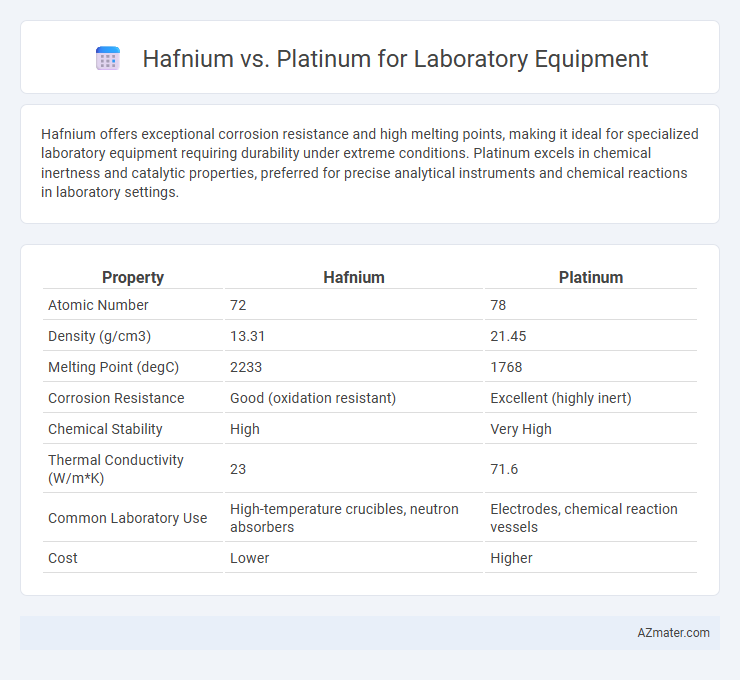Hafnium offers exceptional corrosion resistance and high melting points, making it ideal for specialized laboratory equipment requiring durability under extreme conditions. Platinum excels in chemical inertness and catalytic properties, preferred for precise analytical instruments and chemical reactions in laboratory settings.
Table of Comparison
| Property | Hafnium | Platinum |
|---|---|---|
| Atomic Number | 72 | 78 |
| Density (g/cm3) | 13.31 | 21.45 |
| Melting Point (degC) | 2233 | 1768 |
| Corrosion Resistance | Good (oxidation resistant) | Excellent (highly inert) |
| Chemical Stability | High | Very High |
| Thermal Conductivity (W/m*K) | 23 | 71.6 |
| Common Laboratory Use | High-temperature crucibles, neutron absorbers | Electrodes, chemical reaction vessels |
| Cost | Lower | Higher |
Introduction to Hafnium and Platinum in Laboratory Equipment
Hafnium and platinum are essential materials used in laboratory equipment due to their unique chemical and physical properties. Hafnium is prized for its high melting point, excellent corrosion resistance, and neutron absorption capabilities, making it ideal for nuclear reactors and high-temperature applications. Platinum offers exceptional chemical inertness and thermal stability, commonly used in catalysis, electrodes, and high-precision laboratory instruments, where durability and resistance to chemical attack are critical.
Key Material Properties of Hafnium
Hafnium exhibits exceptional resistance to corrosion and high melting point (2233degC), making it ideal for laboratory equipment exposed to extreme conditions. Its excellent neutron absorption capacity is critical in nuclear applications, offering safety advantages over platinum. Hafnium's superior ductility and thermal stability provide reliable performance in precision instruments requiring durability and resilience.
Key Material Properties of Platinum
Platinum offers exceptional corrosion resistance, high melting point of 1,768degC, and excellent electrical conductivity, making it ideal for laboratory equipment exposed to aggressive chemicals and high temperatures. Its superior chemical inertness ensures minimal contamination and durability in analytical instruments and electrodes. Compared to hafnium, platinum provides greater stability in acidic environments and reliable performance in precision laboratory applications.
Chemical Resistance Comparison
Hafnium exhibits exceptional chemical resistance, particularly against strong acids and alkalis, making it highly durable in aggressive laboratory environments. Platinum also demonstrates excellent corrosion resistance, especially to oxidative and acidic conditions, but may be susceptible to certain halogen acids and hot aqua regia over time. Comparing both, hafnium's superior resistance to a wider range of corrosive chemicals extends equipment longevity in highly reactive applications, while platinum remains preferred for inertness and catalytic processes.
Thermal Stability and Performance
Hafnium exhibits superior thermal stability compared to platinum, maintaining structural integrity at temperatures exceeding 2200degC, making it ideal for high-temperature laboratory equipment applications. Platinum offers excellent chemical resistance but has a lower melting point of about 1768degC, limiting its use in extreme thermal environments. The combination of hafnium's high melting point and resistance to thermal shock ensures enhanced performance in devices requiring prolonged exposure to intense heat.
Cost and Availability Considerations
Hafnium offers a cost-effective alternative to platinum in laboratory equipment due to its lower market price and greater abundance in zirconium ores. Platinum, prized for its exceptional chemical resistance and high melting point, commands a significantly higher price and faces supply constraints from limited mining sources. Laboratories must weigh hafnium's affordability and availability against platinum's superior durability and established use in precision applications.
Common Laboratory Applications for Hafnium
Hafnium is valued in laboratory equipment for its exceptional corrosion resistance and high melting point, making it ideal for crucibles, reactors, and vacuum systems in chemical research and nuclear applications. Its neutron absorption properties enhance its use in control rods and radiation shielding within laboratory nuclear reactors. Compared to platinum, which excels in catalytic and electrochemical processes, hafnium's durability under extreme conditions suits specialized lab environments requiring robust materials resistant to chemical and thermal stress.
Common Laboratory Applications for Platinum
Platinum is widely used in laboratory equipment due to its exceptional chemical resistance, high melting point, and excellent conductivity, making it ideal for crucibles, electrodes, and thermocouples in high-temperature experiments. Common laboratory applications of platinum include catalysis in chemical reactions, precise temperature measurement in thermogravimetric analysis, and as an inert material in sample holders and combustion boats. Unlike hafnium, which is primarily valued for its nuclear properties and corrosion resistance in specialized equipment, platinum's versatility in general laboratory settings is unmatched.
Environmental and Safety Implications
Hafnium's superior corrosion resistance and high melting point make it ideal for laboratory equipment exposed to extreme temperatures and reactive chemicals, reducing risks of contamination and equipment failure. Platinum, while highly inert and biocompatible, poses environmental concerns due to mining impacts and high energy consumption during extraction. Selecting hafnium can improve lab safety by minimizing hazardous waste and lowering environmental footprint compared to platinum-based materials.
Choosing the Right Material: Hafnium or Platinum?
Hafnium offers exceptional corrosion resistance and high melting points, making it ideal for laboratory equipment exposed to extreme temperatures and aggressive chemicals. Platinum provides superior chemical inertness and excellent conductivity, beneficial for precise analytical instruments and electrochemical applications. Selecting between hafnium and platinum depends on the specific laboratory conditions, including temperature tolerance, chemical reactivity, and budget considerations.

Infographic: Hafnium vs Platinum for Laboratory Equipment
 azmater.com
azmater.com